
2002年校级重点课程建设 《跨国经营理论与战略》项目系列成果之二 《跨国经营理论与战略》 教学大纲 项目负责人:范黎波 对外经济贸易大学国际工商管理学院 《跨国经营理论与战略》课题组 二零零四年十月 1
1 2002 年校级重点课程建设 《跨国经营理论与战略》项目系列成果之二 《跨国经营理论与战略》 教学大纲 项目负责人:范黎波 对外经济贸易大学国际工商管理学院 《跨国经营理论与战略》课题组 二零零四年十月
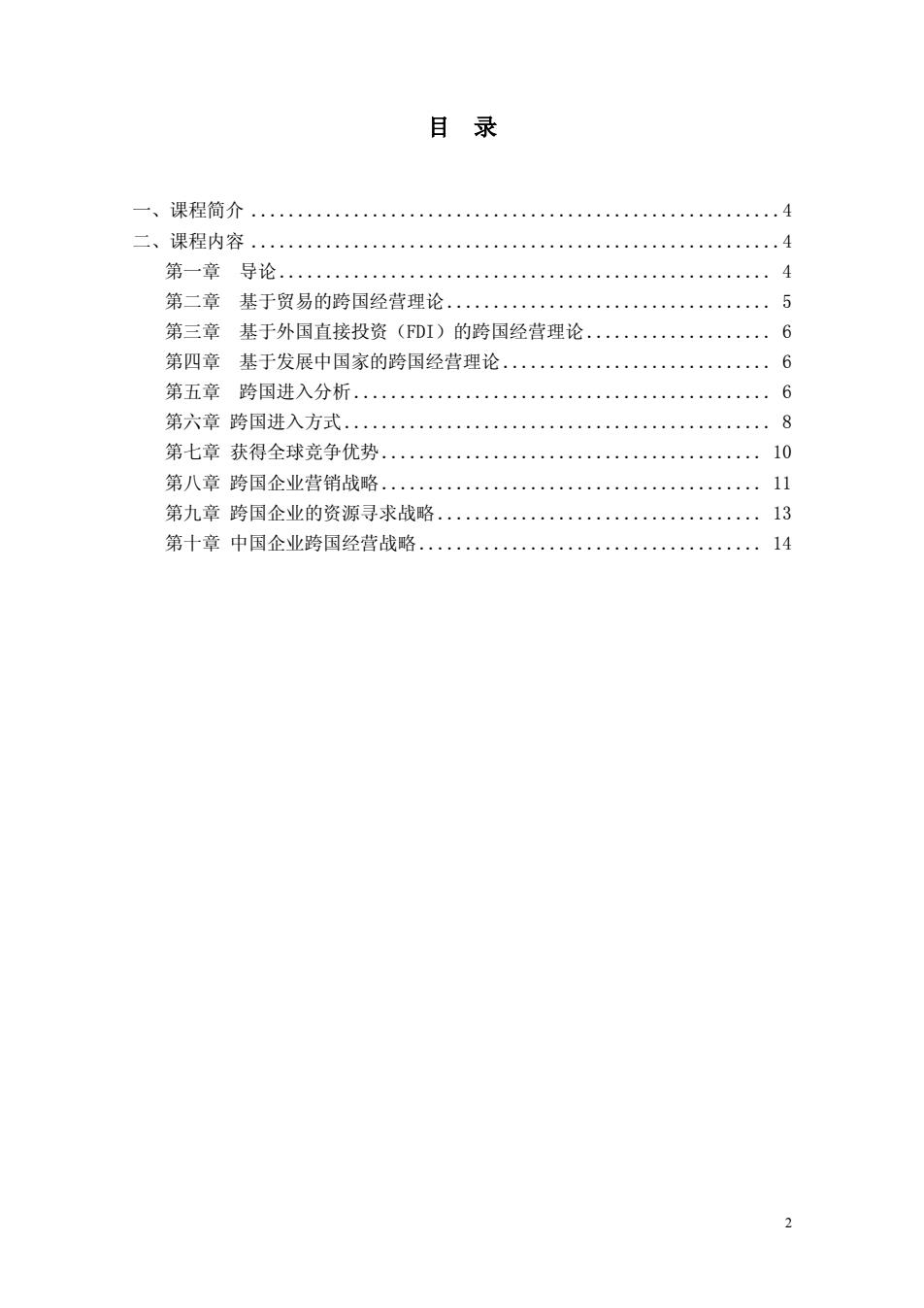
目录 一、课程简介..... 二、课程内容 4 第一章导论 第二章基于贸易的跨国经营理论.….…· 第三章基于外国直接投资(D)的跨国经营理论.· 6 第四章基于发展中国家的跨国经营理论 6 第五章跨国进入分析... 6 第六章跨国进入方式.. 8 第七章获得全球竞争优势... 10 第八章跨国企业营销战略.... 11 第九章跨国企业的资源寻求战略.……… 13 第十章中国企业跨国经营战略.… 14
2 目 录 一、课程简介 .........................................................4 二、课程内容 .........................................................4 第一章 导论..................................................... 4 第二章 基于贸易的跨国经营理论................................... 5 第三章 基于外国直接投资(FDI)的跨国经营理论.................... 6 第四章 基于发展中国家的跨国经营理论............................. 6 第五章 跨国进入分析............................................. 6 第六章 跨国进入方式.............................................. 8 第七章 获得全球竞争优势......................................... 10 第八章 跨国企业营销战略......................................... 11 第九章 跨国企业的资源寻求战略................................... 13 第十章 中国企业跨国经营战略..................................... 14
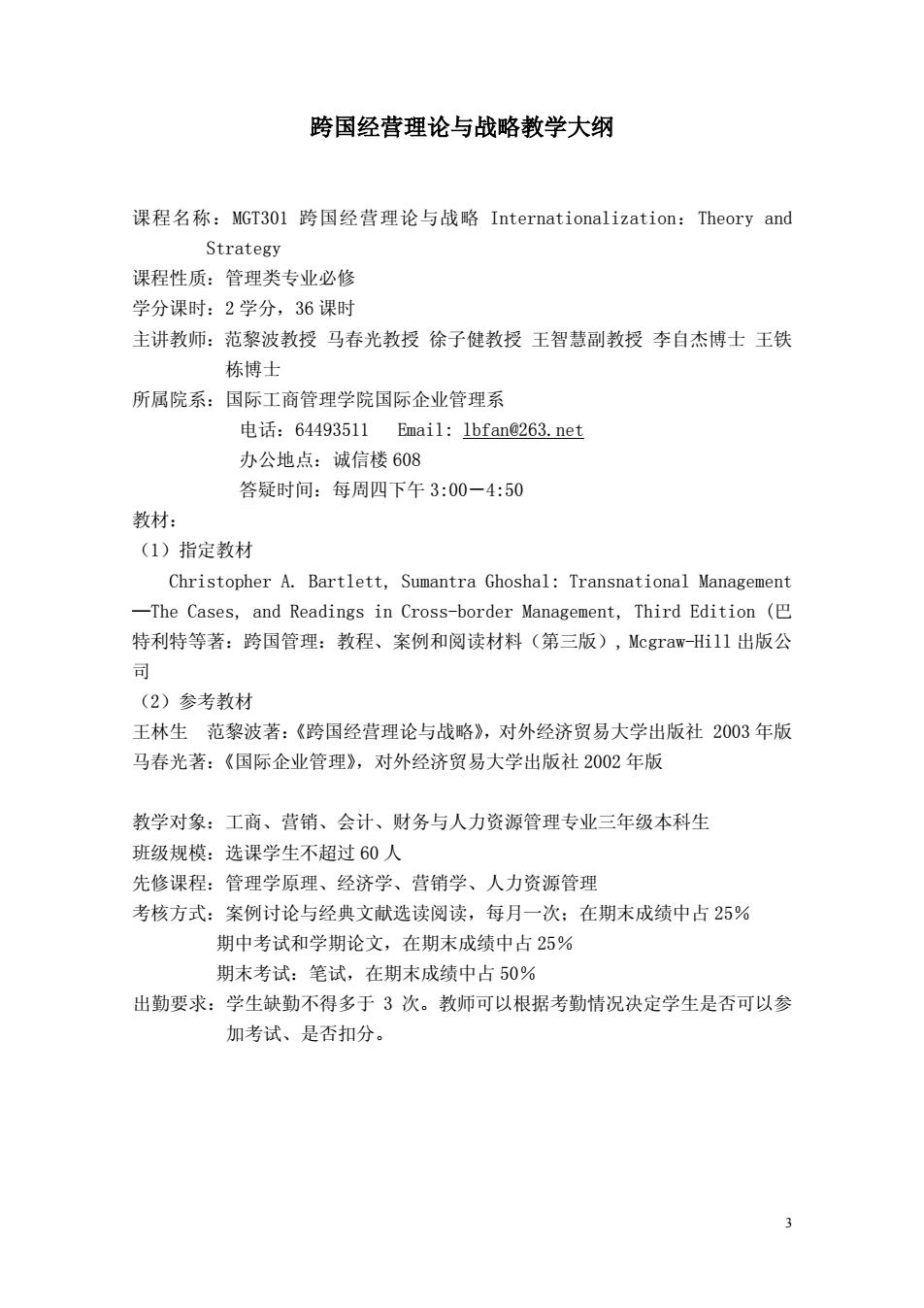
跨国经营理论与战略教学大纲 课程名称:MGT301跨国经营理论与战略Internationalization:Theory and Strategy 课程性质:管理类专业必修 学分课时:2学分,36课时 主讲教师:范黎波教授马春光教授徐子健教授王智慧副教授李自杰博士王铁 栋博士 所属院系:国际工商管理学院国际企业管理系 电话:64493511 Email:1bfan@263.net 办公地点:诚信楼608 答疑时间:每周四下午3:00一4:50 教材: (1)指定教材 Christopher A.Bartlett,Sumantra Ghoshal:Transnational Management -The Cases,and Readings in Cross-border Management,Third Edition 特利特等著:跨国管理:教程、案例和阅读材料(第三版),Mcgraw--Hi11出版公 司 (2)参考教材 王林生范黎波著:《跨国经营理论与战略》,对外经济贸易大学出版社2003年版 马春光著:《国际企业管理》,对外经济贸易大学出版社2002年版 教学对象:工商、营销、会计、财务与人力资源管理专业三年级本科生 班级规模:选课学生不超过60人 先修课程:管理学原理、经济学、营销学、人力资源管理 考核方式:案例讨论与经典文献选读阅读,每月一次;在期末成绩中占25% 期中考试和学期论文,在期末成绩中占25% 期末考试:笔试,在期末成绩中占50% 出勤要求:学生缺勤不得多于3次。教师可以根据考勤情况决定学生是否可以参 加考试、是否扣分。 2
3 跨国经营理论与战略教学大纲 课程名称:MGT301 跨国经营理论与战略 Internationalization:Theory and Strategy 课程性质:管理类专业必修 学分课时:2 学分,36 课时 主讲教师:范黎波教授 马春光教授 徐子健教授 王智慧副教授 李自杰博士 王铁 栋博士 所属院系:国际工商管理学院国际企业管理系 电话:64493511 Email: lbfan@263.net 办公地点:诚信楼 608 答疑时间:每周四下午 3:00-4:50 教材: (1)指定教材 Christopher A. Bartlett, Sumantra Ghoshal: Transnational Management —The Cases, and Readings in Cross-border Management, Third Edition (巴 特利特等著:跨国管理:教程、案例和阅读材料(第三版), Mcgraw-Hill 出版公 司 (2)参考教材 王林生 范黎波著:《跨国经营理论与战略》,对外经济贸易大学出版社 2003 年版 马春光著:《国际企业管理》,对外经济贸易大学出版社 2002 年版 教学对象:工商、营销、会计、财务与人力资源管理专业三年级本科生 班级规模:选课学生不超过 60 人 先修课程:管理学原理、经济学、营销学、人力资源管理 考核方式:案例讨论与经典文献选读阅读,每月一次;在期末成绩中占 25% 期中考试和学期论文,在期末成绩中占 25% 期末考试:笔试,在期末成绩中占 50% 出勤要求:学生缺勤不得多于 3 次。教师可以根据考勤情况决定学生是否可以参 加考试、是否扣分
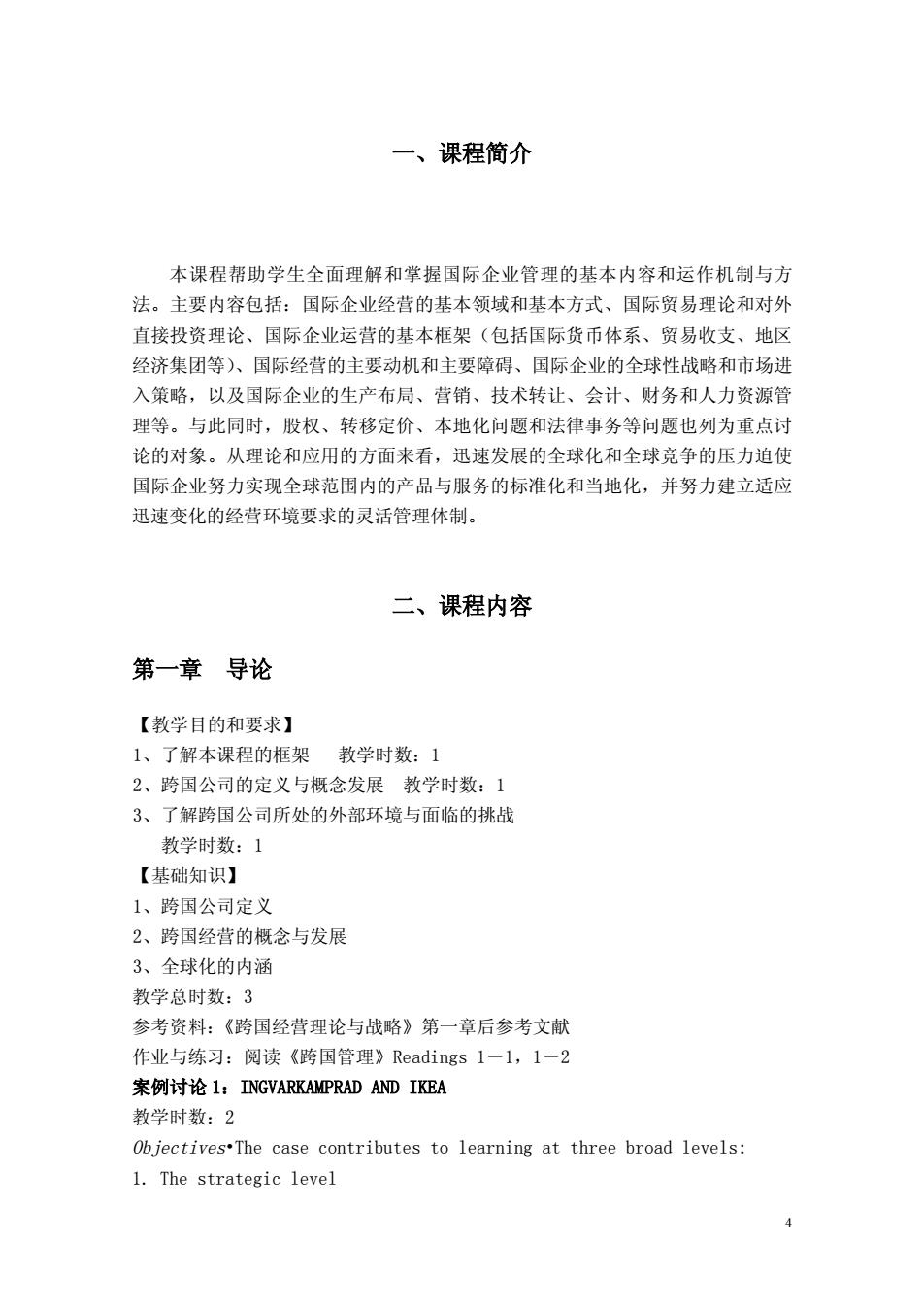
一、课程简介 本课程帮助学生全面理解和掌握国际企业管理的基本内容和运作机制与方 法。主要内容包括:国际企业经营的基本领域和基本方式、国际贸易理论和对外 直接投资理论、国际企业运营的基本框架(包括国际货币体系、贸易收支、地区 经济集团等)、国际经营的主要动机和主要障碍、国际企业的全球性战略和市场进 入策略,以及国际企业的生产布局、营销、技术转让、会计、财务和人力资源管 理等。与此同时,股权、转移定价、本地化问题和法律事务等问题也列为重点讨 论的对象。从理论和应用的方面来看,迅速发展的全球化和全球竞争的压力迫使 国际企业努力实现全球范围内的产品与服务的标准化和当地化,并努力建立适应 迅速变化的经营环境要求的灵活管理体制。 二、课程内容 第一章导论 【教学目的和要求】 1、了解本课程的框架教学时数:1 2、跨国公司的定义与概念发展教学时数:1 3、了解跨国公司所处的外部环境与面临的挑战 教学时数:1 【基础知识】 1、跨国公司定义 2、跨国经营的概念与发展 3、全球化的内涵 教学总时数:3 参考资料:《跨国经营理论与战略》第一章后参考文献 作业与练习:阅读《跨国管理》Readings1一1,1一2 案例讨论1:INGVARKAMPRAD AND IKEA 教学时数:2 Objectives.The case contributes to learning at three broad levels: 1.The strategic level
4 一、课程简介 本课程帮助学生全面理解和掌握国际企业管理的基本内容和运作机制与方 法。主要内容包括:国际企业经营的基本领域和基本方式、国际贸易理论和对外 直接投资理论、国际企业运营的基本框架(包括国际货币体系、贸易收支、地区 经济集团等)、国际经营的主要动机和主要障碍、国际企业的全球性战略和市场进 入策略,以及国际企业的生产布局、营销、技术转让、会计、财务和人力资源管 理等。与此同时,股权、转移定价、本地化问题和法律事务等问题也列为重点讨 论的对象。从理论和应用的方面来看,迅速发展的全球化和全球竞争的压力迫使 国际企业努力实现全球范围内的产品与服务的标准化和当地化,并努力建立适应 迅速变化的经营环境要求的灵活管理体制。 二、课程内容 第一章 导论 【教学目的和要求】 1、了解本课程的框架 教学时数:1 2、跨国公司的定义与概念发展 教学时数:1 3、了解跨国公司所处的外部环境与面临的挑战 教学时数:1 【基础知识】 1、跨国公司定义 2、跨国经营的概念与发展 3、全球化的内涵 教学总时数:3 参考资料:《跨国经营理论与战略》第一章后参考文献 作业与练习:阅读《跨国管理》Readings 1-1,1-2 案例讨论 1:INGVARKAMPRAD AND IKEA 教学时数:2 Objectives•The case contributes to learning at three broad levels: 1. The strategic level
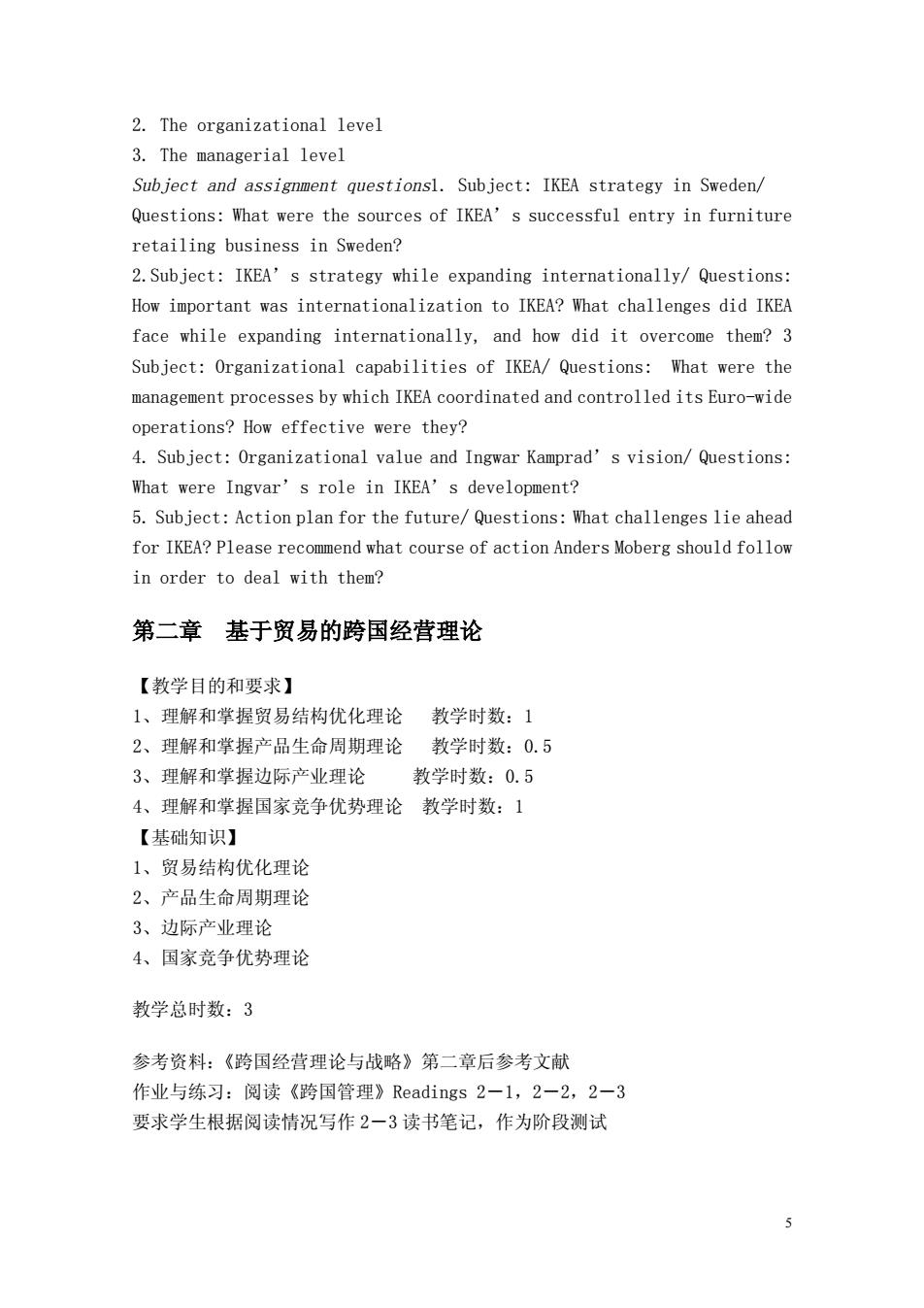
2.The organizational level 3.The managerial level Subject and assignment questionsl.Subject:IKEA strategy in Sweden/ Questions:What were the sources of IKEA's successful entry in furniture retailing business in Sweden? 2.Subject:IKEA's strategy while expanding internationally/Questions: How important was internationalization to IKEA?What challenges did IKEA face while expanding internationally,and how did it overcome them?3 Subject:Organizational capabilities of IKEA/Questions:What were the management processes by which IKEA coordinated and controlled its Euro-wide operations?How effective were they? 4.Subject:Organizational value and Ingwar Kamprad's vision/Questions: What were Ingvar's role in IKEA's development? 5.Subject:Action plan for the future/Questions:What challenges lie ahead for IKEA?Please recommend what course of action Anders Moberg should follow in order to deal with them? 第二章 基于贸易的跨国经营理论 【教学目的和要求】 1、理解和掌握贸易结构优化理论 教学时数:1 2、理解和掌握产品生命周期理论 教学时数:0.5 3、理解和掌握边际产业理论 教学时数:0.5 4、理解和掌握国家竞争优势理论教学时数:1 【基础知识】 1、贸易结构优化理论 2、产品生命周期理论 3、边际产业理论 4、国家竞争优势理论 教学总时数:3 参考资料:《跨国经营理论与战略》第二章后参考文献 作业与练习:阅读《跨国管理》Readings2一1,2-2,2-3 要求学生根据阅读情况写作2一3读书笔记,作为阶段测试
5 2. The organizational level 3. The managerial level Subject and assignment questions1. Subject: IKEA strategy in Sweden/ Questions: What were the sources of IKEA’s successful entry in furniture retailing business in Sweden? 2.Subject: IKEA’s strategy while expanding internationally/ Questions: How important was internationalization to IKEA? What challenges did IKEA face while expanding internationally, and how did it overcome them? 3 Subject: Organizational capabilities of IKEA/ Questions: What were the management processes by which IKEA coordinated and controlled its Euro-wide operations? How effective were they? 4. Subject: Organizational value and Ingwar Kamprad’s vision/ Questions: What were Ingvar’s role in IKEA’s development? 5. Subject: Action plan for the future/ Questions: What challenges lie ahead for IKEA? Please recommend what course of action Anders Moberg should follow in order to deal with them? 第二章 基于贸易的跨国经营理论 【教学目的和要求】 1、理解和掌握贸易结构优化理论 教学时数:1 2、理解和掌握产品生命周期理论 教学时数:0.5 3、理解和掌握边际产业理论 教学时数:0.5 4、理解和掌握国家竞争优势理论 教学时数:1 【基础知识】 1、贸易结构优化理论 2、产品生命周期理论 3、边际产业理论 4、国家竞争优势理论 教学总时数:3 参考资料:《跨国经营理论与战略》第二章后参考文献 作业与练习:阅读《跨国管理》Readings 2-1,2-2,2-3 要求学生根据阅读情况写作 2-3 读书笔记,作为阶段测试
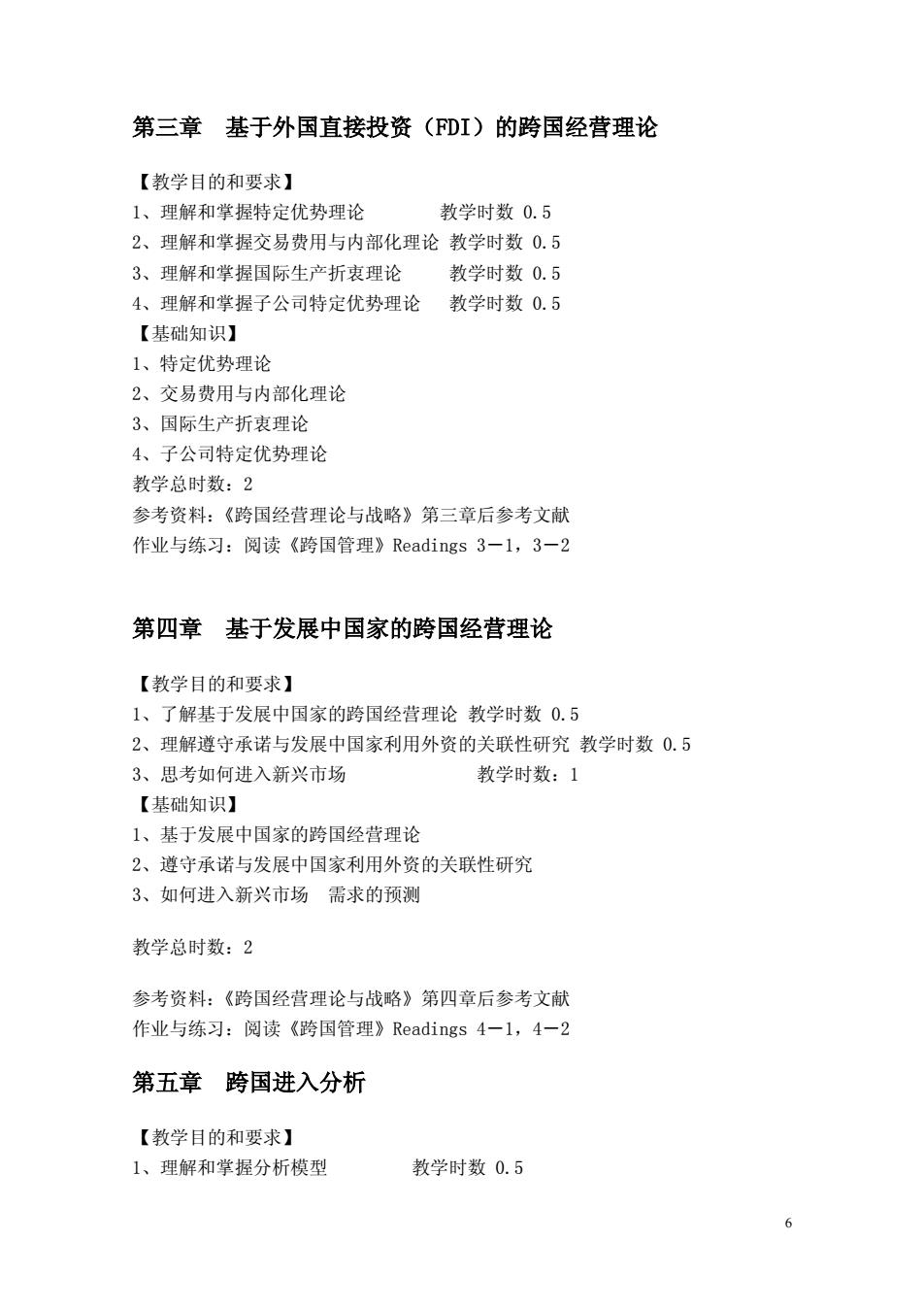
第三章 基于外国直接投资(FDI)的跨国经营理论 【教学目的和要求】 1、理解和掌握特定优势理论 教学时数0.5 2、理解和掌握交易费用与内部化理论教学时数0.5 3、理解和掌握国际生产折衷理论 教学时数0.5 4、理解和掌握子公司特定优势理论 教学时数0.5 【基础知识】 1、特定优势理论 2、交易费用与内部化理论 3、国际生产折衷理论 4、子公司特定优势理论 教学总时数:2 参考资料:《跨国经营理论与战略》第三章后参考文献 作业与练习:阅读《跨国管理》Readings3一1,3一2 第四章 基于发展中国家的跨国经营理论 【教学目的和要求】 1、了解基于发展中国家的跨国经营理论教学时数0.5 2、理解遵守承诺与发展中国家利用外资的关联性研究教学时数0.5 3、思考如何进入新兴市场 教学时数:1 【基础知识】 1、基于发展中国家的跨国经营理论 2、遵守承诺与发展中国家利用外资的关联性研究 3、如何进入新兴市场需求的预测 教学总时数:2 参考资料:《跨国经营理论与战略》第四章后参考文献 作业与练习:阅读《跨国管理》Readings4一1,4一2 第五章跨国进入分析 【教学目的和要求】 1、理解和掌握分析模型 教学时数0.5 6
6 第三章 基于外国直接投资(FDI)的跨国经营理论 【教学目的和要求】 1、理解和掌握特定优势理论 教学时数 0.5 2、理解和掌握交易费用与内部化理论 教学时数 0.5 3、理解和掌握国际生产折衷理论 教学时数 0.5 4、理解和掌握子公司特定优势理论 教学时数 0.5 【基础知识】 1、特定优势理论 2、交易费用与内部化理论 3、国际生产折衷理论 4、子公司特定优势理论 教学总时数:2 参考资料:《跨国经营理论与战略》第三章后参考文献 作业与练习:阅读《跨国管理》Readings 3-1,3-2 第四章 基于发展中国家的跨国经营理论 【教学目的和要求】 1、了解基于发展中国家的跨国经营理论 教学时数 0.5 2、理解遵守承诺与发展中国家利用外资的关联性研究 教学时数 0.5 3、思考如何进入新兴市场 教学时数:1 【基础知识】 1、基于发展中国家的跨国经营理论 2、遵守承诺与发展中国家利用外资的关联性研究 3、如何进入新兴市场 需求的预测 教学总时数:2 参考资料:《跨国经营理论与战略》第四章后参考文献 作业与练习:阅读《跨国管理》Readings 4-1,4-2 第五章 跨国进入分析 【教学目的和要求】 1、理解和掌握分析模型 教学时数 0.5
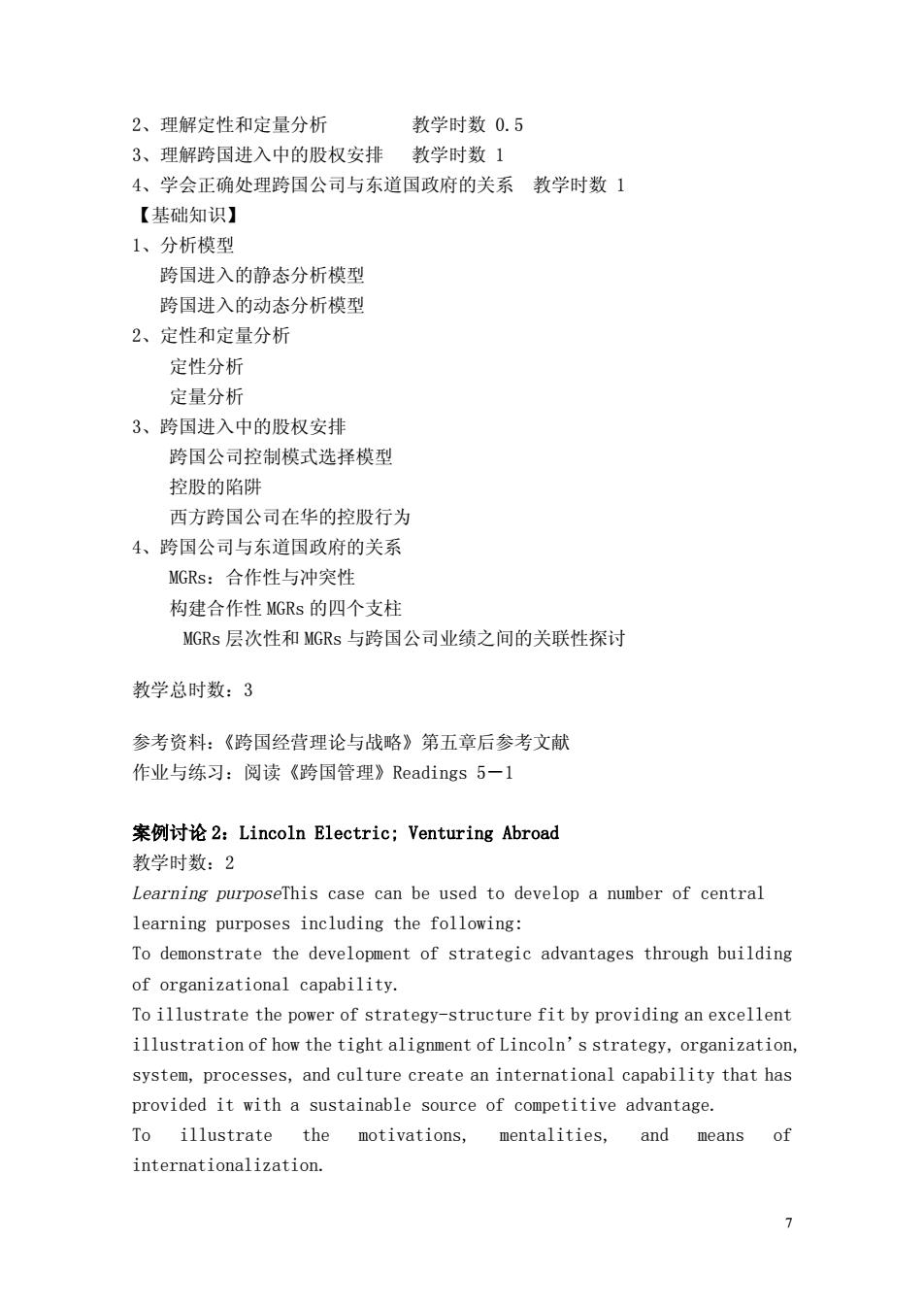
2、理解定性和定量分析 教学时数0.5 3、理解跨国进入中的股权安排 教学时数1 4、学会正确处理跨国公司与东道国政府的关系教学时数1 【基础知识】 1、分析模型 跨国进入的静态分析模型 跨国进入的动态分析模型 2、定性和定量分析 定性分析 定量分析 3、跨国进入中的股权安排 跨国公司控制模式选择模型 控股的陷阱 西方跨国公司在华的控股行为 4、跨国公司与东道国政府的关系 MGRs:合作性与冲突性 构建合作性MGRs的四个支柱 MGRs层次性和MGRs与跨国公司业绩之间的关联性探讨 教学总时数:3 参考资料:《跨国经营理论与战略》第五章后参考文献 作业与练习:阅读《跨国管理》Readings5-l 案例讨论2:Lincoln Electric;Venturing Abroad 教学时数:2 Learning purposeThis case can be used to develop a number of central learning purposes including the following: To demonstrate the development of strategic advantages through building of organizational capability. To illustrate the power of strategy-structure fit by providing an excellent illustration of how the tight alignment of Lincoln's strategy,organization, system,processes,and culture create an international capability that has provided it with a sustainable source of competitive advantage. To illustrate the motivations,mentalities, and means of internationalization. >
7 2、理解定性和定量分析 教学时数 0.5 3、理解跨国进入中的股权安排 教学时数 1 4、学会正确处理跨国公司与东道国政府的关系 教学时数 1 【基础知识】 1、分析模型 跨国进入的静态分析模型 跨国进入的动态分析模型 2、定性和定量分析 定性分析 定量分析 3、跨国进入中的股权安排 跨国公司控制模式选择模型 控股的陷阱 西方跨国公司在华的控股行为 4、跨国公司与东道国政府的关系 MGRs:合作性与冲突性 构建合作性 MGRs 的四个支柱 MGRs 层次性和 MGRs 与跨国公司业绩之间的关联性探讨 教学总时数:3 参考资料:《跨国经营理论与战略》第五章后参考文献 作业与练习:阅读《跨国管理》Readings 5-1 案例讨论 2:Lincoln Electric; Venturing Abroad 教学时数:2 Learning purposeThis case can be used to develop a number of central learning purposes including the following: To demonstrate the development of strategic advantages through building of organizational capability. To illustrate the power of strategy-structure fit by providing an excellent illustration of how the tight alignment of Lincoln’s strategy, organization, system, processes, and culture create an international capability that has provided it with a sustainable source of competitive advantage. To illustrate the motivations, mentalities, and means of internationalization
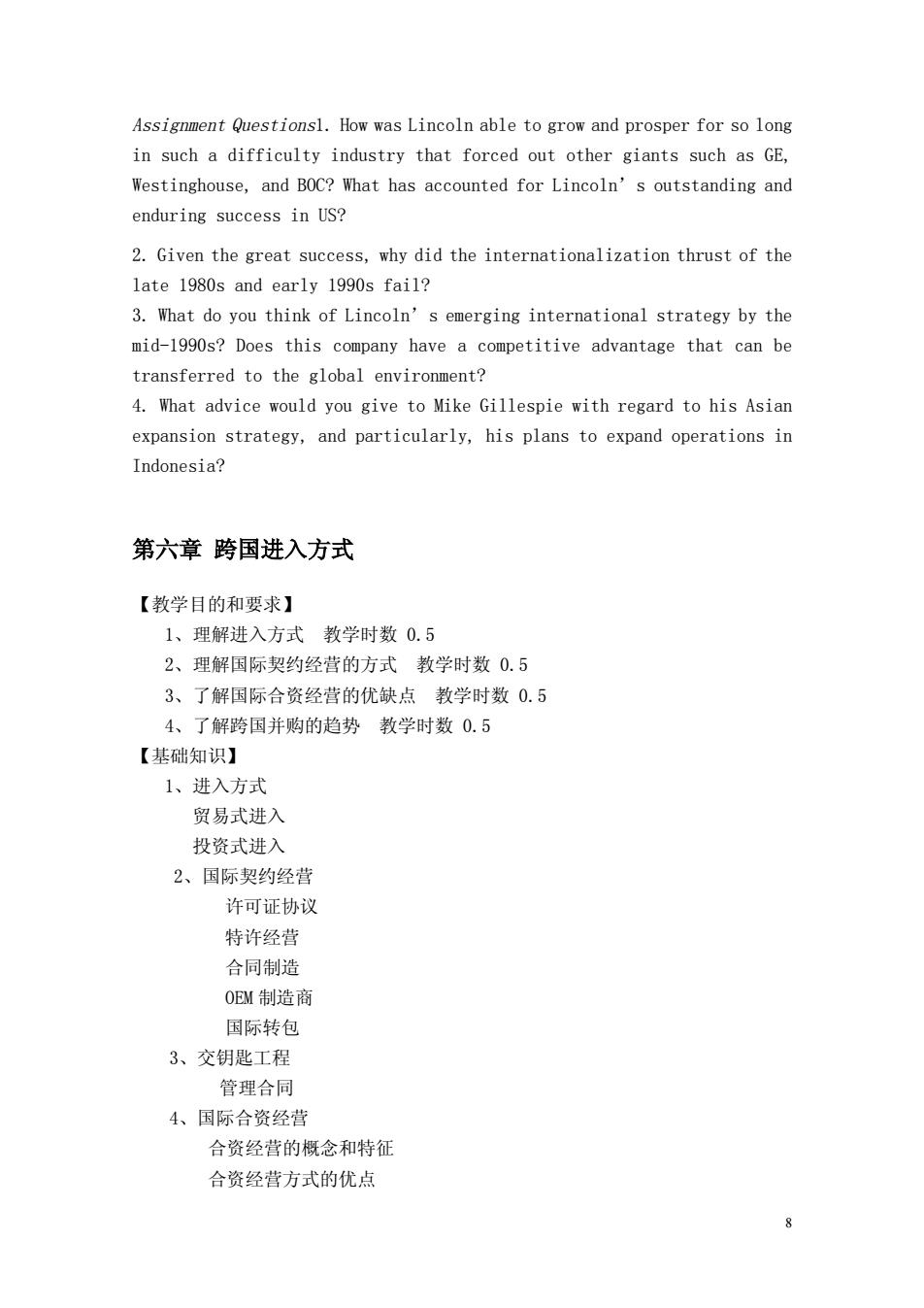
Assignment Questions1.How was Lincoln able to grow and prosper for so long in such a difficulty industry that forced out other giants such as GE, Westinghouse,and BOC?What has accounted for Lincoln's outstanding and enduring success in US? 2.Given the great success,why did the internationalization thrust of the late 1980s and early 1990s fail? 3.What do you think of Lincoln's emerging international strategy by the mid-1990s?Does this company have a competitive advantage that can be transferred to the global environment? 4.What advice would you give to Mike Gillespie with regard to his Asian expansion strategy,and particularly,his plans to expand operations in Indonesia? 第六章跨国进入方式 【教学目的和要求】 1、理解进入方式教学时数0.5 2、理解国际契约经营的方式教学时数0.5 3、了解国际合资经营的优缺点教学时数0.5 4、了解跨国并购的趋势教学时数0.5 【基础知识】 1、进入方式 贸易式进入 投资式进入 2、国际契约经营 许可证协议 特许经营 合同制造 OEM制造商 国际转包 3、交钥匙工程 管理合同 4、国际合资经营 合资经营的概念和特征 合资经营方式的优点
8 Assignment Questions1. How was Lincoln able to grow and prosper for so long in such a difficulty industry that forced out other giants such as GE, Westinghouse, and BOC? What has accounted for Lincoln’s outstanding and enduring success in US? 2. Given the great success, why did the internationalization thrust of the late 1980s and early 1990s fail? 3. What do you think of Lincoln’s emerging international strategy by the mid-1990s? Does this company have a competitive advantage that can be transferred to the global environment? 4. What advice would you give to Mike Gillespie with regard to his Asian expansion strategy, and particularly, his plans to expand operations in Indonesia? 第六章 跨国进入方式 【教学目的和要求】 1、理解进入方式 教学时数 0.5 2、理解国际契约经营的方式 教学时数 0.5 3、了解国际合资经营的优缺点 教学时数 0.5 4、了解跨国并购的趋势 教学时数 0.5 【基础知识】 1、进入方式 贸易式进入 投资式进入 2、国际契约经营 许可证协议 特许经营 合同制造 OEM 制造商 国际转包 3、交钥匙工程 管理合同 4、国际合资经营 合资经营的概念和特征 合资经营方式的优点
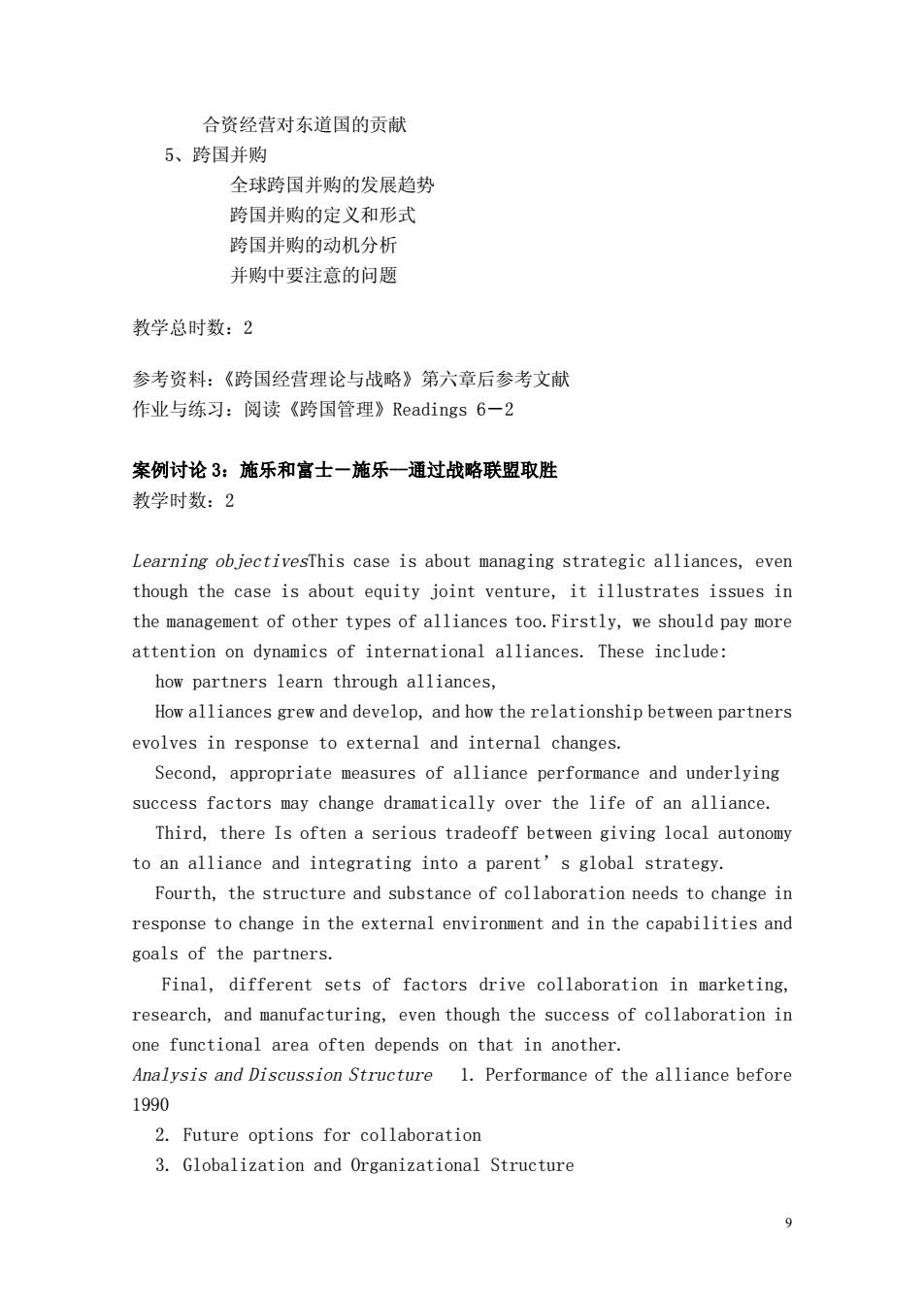
合资经营对东道国的贡献 5、跨国并购 全球跨国并购的发展趋势 跨国并购的定义和形式 跨国并购的动机分析 并购中要注意的问题 教学总时数:2 参考资料:《跨国经营理论与战略》第六章后参考文献 作业与练习:阅读《跨国管理》Readings6-2 案例讨论3:施乐和富士一施乐一通过战略联盟取胜 教学时数:2 Learning objectivesThis case is about managing strategic alliances,even though the case is about equity joint venture,it illustrates issues in the management of other types of alliances too.Firstly,we should pay more attention on dynamics of international alliances.These include: how partners learn through alliances, How alliances grew and develop,and how the relationship between partners evolves in response to external and internal changes. Second,appropriate measures of alliance performance and underlying success factors may change dramatically over the life of an alliance. Third,there Is often a serious tradeoff between giving local autonomy to an alliance and integrating into a parent's global strategy. Fourth,the structure and substance of collaboration needs to change in response to change in the external environment and in the capabilities and goals of the partners. Final,different sets of factors drive collaboration in marketing, research,and manufacturing,even though the success of collaboration in one functional area often depends on that in another. Analysis and Discussion Structure 1.Performance of the alliance before 1990 2.Future options for collaboration 3.Globalization and Organizational Structure
9 合资经营对东道国的贡献 5、跨国并购 全球跨国并购的发展趋势 跨国并购的定义和形式 跨国并购的动机分析 并购中要注意的问题 教学总时数:2 参考资料:《跨国经营理论与战略》第六章后参考文献 作业与练习:阅读《跨国管理》Readings 6-2 案例讨论 3:施乐和富士-施乐--通过战略联盟取胜 教学时数:2 Learning objectivesThis case is about managing strategic alliances, even though the case is about equity joint venture, it illustrates issues in the management of other types of alliances too.Firstly, we should pay more attention on dynamics of international alliances. These include: how partners learn through alliances, How alliances grew and develop, and how the relationship between partners evolves in response to external and internal changes. Second, appropriate measures of alliance performance and underlying success factors may change dramatically over the life of an alliance. Third, there Is often a serious tradeoff between giving local autonomy to an alliance and integrating into a parent’s global strategy. Fourth, the structure and substance of collaboration needs to change in response to change in the external environment and in the capabilities and goals of the partners. Final, different sets of factors drive collaboration in marketing, research, and manufacturing, even though the success of collaboration in one functional area often depends on that in another. Analysis and Discussion Structure 1. Performance of the alliance before 1990 2. Future options for collaboration 3. Globalization and Organizational Structure

4.Conclusion 第七章获得全球竞争优势 【教学目的和要求】 1、了解全球运营与价值创造的方式教学时数0.5 2、学会运用获得全球竞争优势结构设计的方法教学时数1 3、了解管理全球价值链 教学时数0.5 4、理解竞争性企业战略 教学时数0.5 5、掌握跨国企业的竞争模式教学时数0.5 【基础知识】 1、全球运营与价值创造 应当地市场 寻求全球的规模经济性 开发全球的范围经济性 为价值活动和资源配置选择最佳的区位 跨地区的知识转移最大化 2、获得全球竞争优势结构设计 设计最优的网络结构 建立世界一流的地区竞争力 确保无磨擦的合作 3、 管理全球价值链 价值链的概念和构成 战略环节和竞争优势 基于价值链的国际分工和地区业务布局 价值链与国际营销策略选择 中国企业的基本策略:在价值链中找准位置 4、竞争性企业战略 跨国企业的定位 竞争性企业战略 在东道国市场上取得成功 启示与建议 5、 跨国企业的竞争模式 产品战略—领先的产品设计 顾客战略——锁定顾客 竞争战略—一战胜竞争对手 10
10 4. Conclusion 第七章 获得全球竞争优势 【教学目的和要求】 1、了解全球运营与价值创造的方式 教学时数 0.5 2、学会运用获得全球竞争优势结构设计的方法 教学时数 1 3、了解管理全球价值链 教学时数 0.5 4、理解竞争性企业战略 教学时数 0.5 5、掌握跨国企业的竞争模式 教学时数 0.5 【基础知识】 1、 全球运营与价值创造 应当地市场 寻求全球的规模经济性 开发全球的范围经济性 为价值活动和资源配置选择最佳的区位 跨地区的知识转移最大化 2、 获得全球竞争优势结构设计 设计最优的网络结构 建立世界一流的地区竞争力 确保无磨擦的合作 3、 管理全球价值链 价值链的概念和构成 战略环节和竞争优势 基于价值链的国际分工和地区业务布局 价值链与国际营销策略选择 中国企业的基本策略:在价值链中找准位置 4、 竞争性企业战略 跨国企业的定位 竞争性企业战略 在东道国市场上取得成功 启示与建议 5、 跨国企业的竞争模式 产品战略——领先的产品设计 顾客战略——锁定顾客 竞争战略——战胜竞争对手